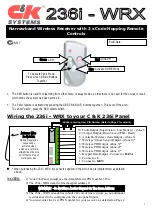
iG5 User Manual
46
> 90% observations used or > 80% # Fixed Ambiguities
> 50% Fixed Ambiguities or > 95% observations used
Overall RMS < 0.030(m)
Both Lat and Lon Peak-to-Peak < 0.030(m)
Ellipsoid Height Peak-to-Peak < 0.040(m)
If you collect data under canopy or in an area where there are
buildings or trees that obstruct the view above 10° elevation,
the number of observations used will be lower.
Make sure you use the left-hand column (NAD_83) results,
not the right-hand column (IGS08) unless you know you want
IG5 framed results.
Be careful with heights. Both ellipsoid and orthometric
heights are listed. The orthometric height is NAVD88 GPS
derived and typically is the elevation you need.
The Peak-to-Peak error estimate for the orthometric height
includes the error estimate for the GEOID in addition to the
Peak-to-Peak error estimate value for the ellipsoid height.
US Survey Feet vs. International Feet, Scale
Factors
IMPORTANT: The state plane coordinates are listed at the
bottom in the right-hand column. They are in Meters. If you
need Feet, you can convert them, however be careful to
convert to International Feet or U.S. Survey Feet as required
by your State and application:
US Survey Feet
= Meters * (3937/1200)
International Feet
= Meters / 0.3048
The misapplication of Ft/M scale factor can result in a 30 foot
coordinate blunder!
If you request an ‘Extended Format’
OPUS results, the state plane coordinates are computed and
returned at the bottom of the report in the nominal foot type
for the area .
If your survey is at a significant elevation (> 100 feet) you may
need to apply the Combined Factor (listed on the OPUS
report for both UTM and State Plane Coordinates) to inversed
distances to match optical shots made at ground level.
Содержание iG5
Страница 1: ...iG5 Static GNSS Receiver User Manual Revision V 2021 03 23...
Страница 4: ...iG5 User Manual 4...
Страница 50: ...iG5 User Manual 50...
















































